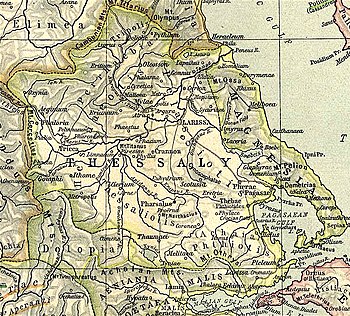Phacium

Phacium or Phakion (Ancient Greek: Φάκιον) was a town and polis (city-state)[1] of ancient Thessaly, in the district Pelasgiotis.
Brasidas marched through Phacium in 424 BCE.[2] In the Second Macedonian War, Livy mentions that it was one of the cities devastated by Philip V of Macedon the year 198 BCE, together with Iresiae, Euhydrium, Eretria and Palaepharsalus, since he foresaw that the territory would soon fall into the hands of the Aetolian League and the Romans. Philip allowed the men who were able to follow him, but they were compelled to quit their homes and the towns were burnt. All the property they could carry with them they were allowed to take away, the rest became the booty for the soldiers.[3] The town was occupied by the Roman praetor Marcus Baebius Tamphilus in the war with Antiochus III in 191 BCE.[4]
The site of Phacium has not been securely located; some scholars suggest a site on left bank of the Peneius river (at ).[5]
References[]
- ^ Mogens Herman Hansen & Thomas Heine Nielsen (2004). "Thessaly and Adjacent Regions". An inventory of archaic and classical poleis. New York: Oxford University Press. p. 701. ISBN 0-19-814099-1.
- ^ Thucydides. History of the Peloponnesian War. 4.78.
- ^ Livy. Ab Urbe Condita Libri (History of Rome). 32.13.
- ^ Livy. Ab Urbe Condita Libri (History of Rome). 36.13.
- ^ Richard Talbert, ed. (2000). Barrington Atlas of the Greek and Roman World. Princeton University Press. p. 55, and directory notes accompanying.
![]() This article incorporates text from a publication now in the public domain: Smith, William, ed. (1854–1857). "Phacium". Dictionary of Greek and Roman Geography. London: John Murray.
This article incorporates text from a publication now in the public domain: Smith, William, ed. (1854–1857). "Phacium". Dictionary of Greek and Roman Geography. London: John Murray.
- Populated places in ancient Thessaly
- Former populated places in Greece
- Lost ancient cities and towns
- Pelasgiotis
- Cities in ancient Greece
- Thessalian city-states
- Ancient Thessaly geography stubs